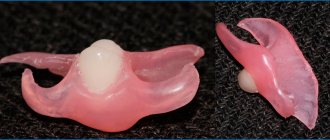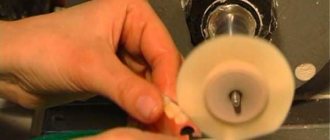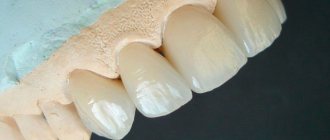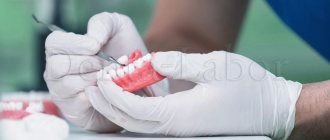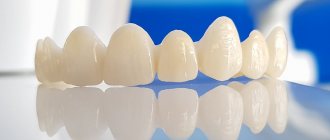The main indications for this type of prosthetics are visible defects in the upper or lower dentition. Also, dentures can be installed if the defects are terminal, that is, part of the lateral teeth is lost.
There are also contraindications to this procedure. These include:
- inflammatory processes in the oral cavity;
- the presence of diseases of internal organs, especially the gastrointestinal tract.
Also, it will not be possible to carry out clasp prosthetics if the patient does not have supporting teeth to which the prosthesis could be attached. Therefore, having healthy teeth that can be secured with crowns is a must.
Advantages and disadvantages
Clasp dentures are used very often. This is due to the fact that their installation does not require much time, and the procedure itself does not have many contraindications. In addition, after such prosthetics, the patient practically does not feel any discomfort - his diction does not change, he can easily eat all the food he is accustomed to. In the first days after installation of the prosthesis, a slight pressure may be felt, since the presence of a foreign body in the mouth will be unusual. However, within a week all such sensations will pass.
Another advantage of clasp dentures is their durability. It is these structures that are the most durable compared to any other prostheses. This applies to both mechanical effects on them and physical or chemical ones. This type of structure can be worn around the clock; it will remain stably in a given position.
But the main advantage of this type of prosthesis is that it completely preserves the aesthetic appearance of the dentition. During the procedure, the specialist will select the design option that will fully match the color and shape of the patient’s natural teeth. Thus, people around you will not notice the presence of an artificial element in your mouth at all.
As for the disadvantages of clasp dentures, they include the following:
- quite high price, which is compensated by a long period of use;
- mandatory presence of supporting teeth to fix the structure;
- temporary discomfort in the first days after installation, which soon disappears completely.
The last of the minuses is quite insignificant, given that after a few days a person will absolutely not notice the presence of a prosthesis and will be able to lead his usual lifestyle, enjoying his smile.
An alternative to telescopic structures
What can modern dentistry offer if a prosthesis on “telescopes” is not suitable for you for some reason? There are other methods of restoring teeth:
- removable products with clasps: seriously inferior to telescopic systems in aesthetics,
- clasp products with attachments (micro-locks): a good option, but not suitable if you have few teeth,
- nylon structures: inferior in terms of service life. In addition, they cannot be corrected in case of tooth loss,
- installation of implants: recognized as the best possible alternative, but much more expensive.
The choice of a specific method largely depends on the characteristics of the clinical picture, including the number of lost teeth and the financial capabilities of the patient. You need to understand that the best solution that will restore the appearance and full functionality of the dentofacial apparatus, as well as stop the atrophic processes in the jaw bone tissue, is dental implantation.
General classification of clasp dentures
Dentures vary in many ways. This includes their location in the oral cavity, the method of attachment, etc. It is very important that at the installation stage the specialist correctly selects the appropriate option, because the comfort while wearing this design will depend on this.
By location
Based on the location of the structure in the mouth, all options are divided into the following types:
- clasp denture for the upper or lower jaw;
- one-sided or two-sided clasp prosthesis.
The first type is designed to be placed on the patient's upper jaw. They can have different shapes and designs, which depend on the degree of damage to the dentition. A distinctive feature of such prostheses is the presence of a special bridge on the palatal part, which has the shape of a plate. It is needed to normalize chewing activity and provide greater stability.
Clasp prosthetics of the lower jaw is carried out using a similar design. However, this takes into account the presence of mucous membranes and tongue, which should not be damaged. Therefore, in this case, a non-flat bridge is used that does not touch the floor of the mouth. It is placed closer to the front teeth, which eliminates any discomfort while eating or talking.
One-sided clasp dentures are used when missing teeth are observed only on the right or left side of the jaw. In this case, the second half is not used. Most often, the need for such prosthetics occurs when there is an end defect. In this case, the prosthesis is attached to crowns, which are placed on one or two outer healthy teeth. The advantage of this design is that it transfers the greatest load precisely to these intact teeth, easing the impact on the prosthesis and the gums underneath it.
Important! In the case where the outer teeth on the desired side are not preserved, the prosthesis can be attached to the healthy tooth opposite. This uses a small plate to hold the structure in place.
Bilateral clasp dentures are used if dentition defects are present on both sides of the jaw. Its design is the prosthesis itself, which imitates healthy teeth and gums underneath them, as well as a bridge connecting both halves.
According to the material of manufacture
For the manufacture of such prostheses, various materials are used, which determine the price of the design and the prosthetic procedure itself, as well as the quality of wear and aesthetic effect. The most popular are metal options. They can be made from alloys of noble metals, such as gold, and from titanium or cobalt-chrome alloys. These types of prostheses are very durable and made of steel.
Important! In cases where a person has allergic reactions to many materials, the best option is a titanium prosthesis. It is the one that is most compatible with the human body.
The modern and most aesthetically pleasing type are structures made from technical polymers. They received the name “Quattro Ti”, corresponding to the name of the Italian company that produces them. This material is a heavy-duty plastic that eliminates the need for additional metal reinforcement.
Among the advantages of QuattroTi clasp dentures are:
- possibility of fastening the structure without preliminary grinding of teeth;
- high biocompatibility with the body;
- absence of traumatic effect when located close to the mucous membrane;
- the material does not absorb odors and does not become pigmented after eating food.
This prosthesis has a long service life, which exceeds 7 years.
By type of fastening
Depending on how the design of the prosthesis is attached to the dentition, they are divided into the following types:
- on telescopic crowns;
- on clasps;
- on attachments.
The telescopic clasp prosthesis is attached using special composite crowns. Its removable part looks like a regular set of teeth with imitation gums at the bottom. This design is hollow inside. The second part, namely the supporting base, is a stump, which is ground to the desired shape and covered with metal on top. It is to this that the removable part is attached.
Clasp options can be used if the retained teeth are placed at either end of the empty area. This is due to the fact that this design is attached using simple metal hooks and needs to be fixed on both sides. This type is considered the most budget-friendly and easiest to use.
Clasp dentures with attachments are similar to the previous version, but instead of hooks, special locks are used here, which are more reliable. One side is attached to the removable part, and the other is built into a healthy tooth and covered with a crown for fixation. Such fasteners are invisible on the front part of the dentition, which ensures high aesthetics of use of the structure.
Contraindications for implant installation
- General contraindications include diseases such as diabetes, AIDS, hypertension, cancer, bleeding disorders, diseases of the nervous and immune systems, and bone tissue.
- Implants are not placed on children and adolescents because during the growth period the implants become loose and can be rejected by the body. In addition, installed implants can lead to slower growth of individual organs.
- Implants are not installed during pregnancy and lactation.
- Specific contraindications for installing implants include the proximity of the maxillary sinuses, or sinuses. The width and density of the bone tissue of the upper jaw is also of great importance, especially at the point of contact with the sinuses. If it is insufficient, sinusplasty will have to be performed before installing implants.
- The installation of implants is contraindicated in case of chronic diseases, especially diseases of the oral cavity, as well as if the patient does not comply with the rules of personal hygiene.
- If the patient has insufficient height and bone density in both the lower and upper jaws, it is necessary to undergo bone grafting before installing implants.
Clasp prosthetics on implants
There are cases when prosthetics are the only possible option for restoring the aesthetics of the dentition, but there are no longer any healthy teeth to attach the prosthesis in the right places. This problem can be solved by using implants. These are artificial teeth that are screwed into the jawbone. Most often these are lateral tooth sockets. After such implants take root and the doctor allows you to move on to prosthetics, the removable structure can be installed according to the standard scheme.
Indications for prosthetics
Clasp dentures are installed on the lower jaw if:
- there is an extensive defect - for example, more than two teeth in a row are missing;
- all teeth are completely missing - in this case, to fix the prosthesis, the patient is first implanted with supporting implants;
- the last teeth in the row are missing;
- The patient has chronic periodontitis and there is a need to additionally strengthen the remaining teeth in the row with the help of a prosthesis.
In the meantime, prosthetics with clasp artificial structures are not recommended when:
- there are less than four teeth left in the jaw - unfortunately, this is not enough for a high-quality support base;
- the patient suffers from acute chronic illnesses;
- bone problems have been diagnosed (for example, osteomyelitis of the jaw, as well as osteoporosis);
- a person has an inflamed oral mucosa.
Which clasp dentures are best for teeth?
There are a large number of options for this type of prosthesis. Each of them has its own advantages and slight disadvantages. In addition, each patient who seeks prosthetics has his own individual physiological characteristics. That is why there is no clear answer to the question of which prosthesis is better to choose.
A specialist must evaluate the nature of the damage to the dentition and the possibility of its restoration. Only a doctor will be able to choose the most suitable prosthesis, which will not only look as advantageous as possible, but will also not cause any discomfort when using it.
The iOrtho clinic network provides high-quality services for correcting malocclusion with Invisalign aligners, sign up for a consultation now!
Advantages and disadvantages of implants
If no contraindications are identified, then dentists advocate implantation. The only people against implants are doctors who do not have sufficient qualifications to perform such operations and recommend the installation of a removable prosthesis in their own interests, and not in the interests of the patient.
After all, the undeniable advantages of implantation are the restoration of the functions of a lost tooth, the prevention of deformation of bone tissue and facial features, and the absence of the need to grind adjacent teeth.
For many, the rather high price can be an obstacle to installing implants. But implantation pays off in the future, because as stated above, I install implants for almost my entire life.
Materials for making the structure
Dentures are made from dental hypoallergenic alloys. They do not oxidize and do not emit any hazardous substances. Ideally, both parts of the structure, including telescopic crowns, are made from the same material (for example, gold).
An alternative option is also possible - galvanic technology. For the main part, alloys of base metals or zirconium dioxide are used (the designs are not as accurate as those made from gold, but are cheaper), and for the outer part, gilding is used.
Each design is made taking into account the individual characteristics of the patient. If necessary, it can always be redone (this is more economical than restoring the dentition again).
On average, it takes 3-4 weeks to manufacture the bridge itself - the removable part. A primary telescopic crown can be made in 3 days. Otherwise, everything depends on the amount of work to correct the supporting teeth.
Life time
The service life of a prosthesis varies from person to person, and telescopic structures are no exception. On average, the prosthesis lasts for about 3 years without creating any problems. If the condition of the teeth does not deteriorate or the telescopic denture is installed on implants, it will last up to 10 years.
The service life is affected not only by the condition of the teeth and oral cavity. The structure gradually wears out and the fastening of the crowns becomes loose. This can be caused both by errors made during manufacturing and installation, and by violations of the operation of the prosthesis. In order for it to serve for a long time, you need to regularly visit the dentist for examination and correction.
Installation Features
Prosthetics includes several stages:
- preparation, preliminary examination, diagnostics;
- if necessary, support units are treated and infectious tissue lesions are eliminated;
- taking impressions, installing a temporary structure;
- making a prosthesis, fitting;
- installation of a clasp structure.
Rules of care
The service life of clasp dentures is on average five years. But to avoid complications and extend service life, you must follow the following rules of care:
- regular cleaning of teeth, including the surface of the prosthesis using paste, brush, irrigator;
- after each meal, the oral cavity should be rinsed with special solutions;
- You should periodically visit a doctor for preventive examinations.
Approximate prices
The average price for clasp dentures in St. Petersburg is 27-45 thousand rubles. But the exact cost can be increased due to the following factors:
- diagnostic procedures before prosthetics;
- the need for treatment before prosthetics;
- number of units to be reimbursed;
- materials used to make the structure;
- types of locks for fixation.
To make an appointment or get additional information about the installation of prostheses, the cost and features of treatment, please contact us by phone. Call us and make an appointment at a time convenient for you.





